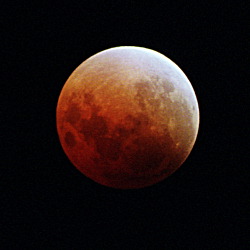The lunar eclipse is caused by the shadow of the Earth falling on the
Moon. This can only happen if the Moon is in the full moon phase. The lunar
eclipse, including total eclipses, is far from being such a rare phenomenon as
the solar eclipse is. This is because the lunar eclipse is visible all over
the hemisphere tilted towards the Moon at the moment of the eclipse.
People observing the lunar eclipse from different places on our planet
at the same time have roughly the same view. The only difference is the
viewing angle but the distance of the Moon from the Earth, about 384,400 km,
makes the difference insignificant.

Although from a strictly scientific point of view the total lunar eclipse
is not such a valuable natural phenomenon as the solar eclipse, it is well worth
observing as it gives rise to some spectacular effects. The most interesting is
the fact that the Moon, although completely submerged in the Earth's umbra is
usually clearly visible in the sky and has an extraordinary red-orange color.
If, at the moment of the total lunar eclipse, we were not standing on the
Earth, but on the Moon, we would be able to observe the eclipse of the Sun by
the Earth. We would witness a breath-taking view of the Earth in the sky
covering the Sun. Viewing the unilluminated hemisphere of the Earth, our
planet would be dark but with a bright colorful ring around it created by
the atmosphere. The glaring ring would display of all shades of yellow,
orange and red - colors which we can observe in the sky on the Earth
after sunset. The brightness of this colorful ring is sufficient to
light up the lunar surface. As the color and brightness of the ring
depend on the actual state of the Earth's atmosphere each eclipse is
an unrepeatable original.
Back to the Earth now. The Moon surface of which has a neutral grey color
takes on the color of the bright ring of the Earth's atmosphere i.e.
the red-orange color. The unforgettable moment to be retained forever
in the memory of everybody who could observe it through a telescope
comes shortly after totality has ended when the first bright
rays of sunlight hit the lunar surface. This is also the moment when the
picture on this page was taken.
September 16, 1997,
Tair 3 4.5/300mm with tele converter TK2M
(equivalent focus length 600mm),
Kodak Gold ZOOM 800
